Nelson College Management Accounting Report: GSQ Limited Analysis
VerifiedAdded on 2023/01/12
|11
|698
|49
Report
AI Summary
This report delves into the realm of management accounting, specifically analyzing marginal and absorption costing methods. It begins with an introduction to management accounting and then proceeds to analyze the concepts of marginal and absorption costing. The report uses GSQ Limited as a case study to illustrate the application of these costing techniques. The report includes income statements prepared under both marginal and absorption costing, allowing for a comparison of their impacts on profit calculation. The analysis includes working notes to explain the calculations. The report concludes with a recommendation for GSQ Limited on which costing approach is most suitable, and a brief conclusion summarizing the key takeaways. References are provided at the end of the report.

Management Accounting
Paraphrase This Document
Need a fresh take? Get an instant paraphrase of this document with our AI Paraphraser
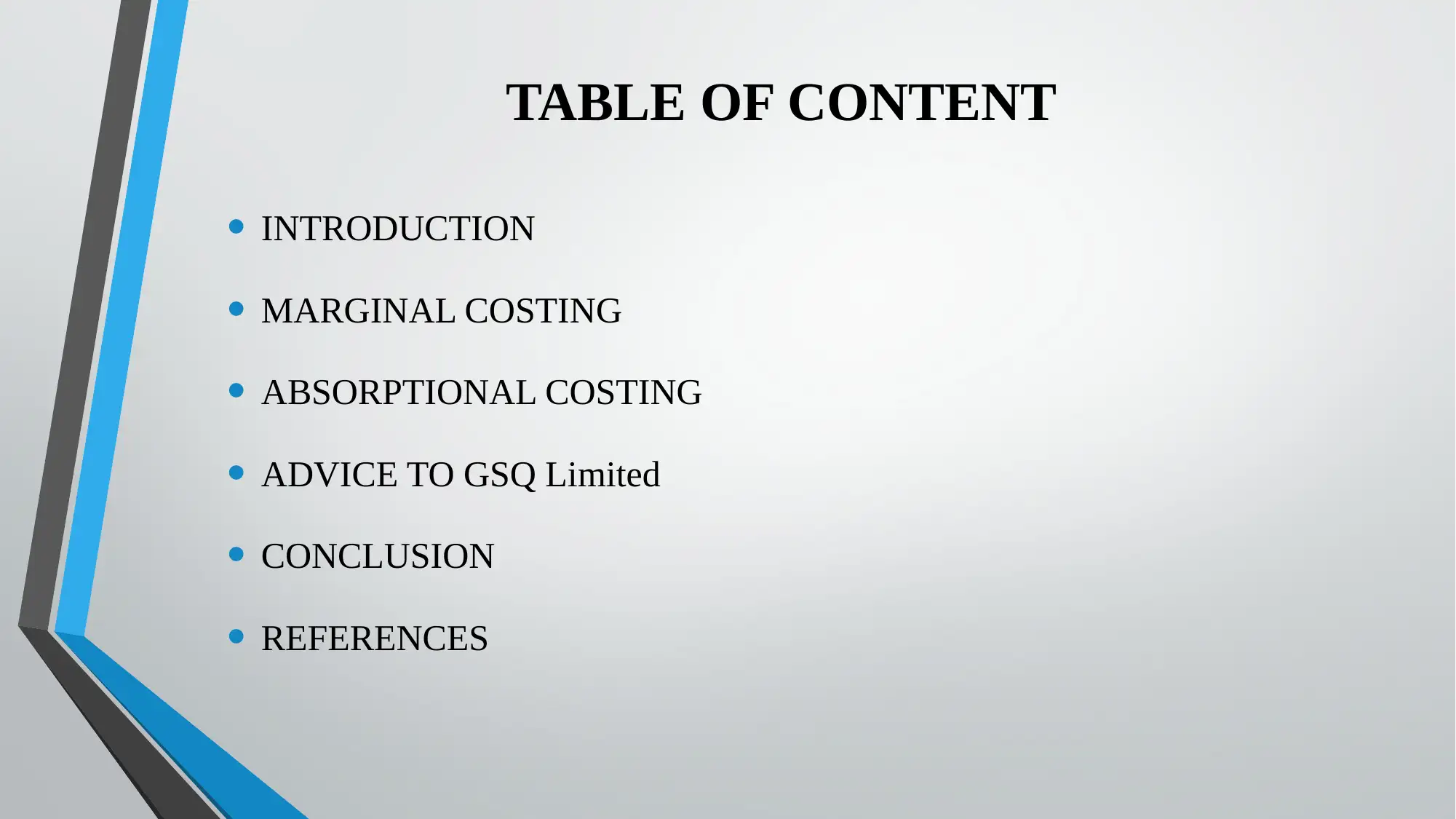
TABLE OF CONTENT
• INTRODUCTION
• MARGINAL COSTING
• ABSORPTIONAL COSTING
• ADVICE TO GSQ Limited
• CONCLUSION
• REFERENCES
• INTRODUCTION
• MARGINAL COSTING
• ABSORPTIONAL COSTING
• ADVICE TO GSQ Limited
• CONCLUSION
• REFERENCES

Introduction
• Management accounting is the concept of analysis and reporting income and
expenditures which an organization earns and expends while operating in
business environment.
• For this purpose, a company is selected which is GSQ Limited.
• In this presentation, an analysis of marginal and absorption costing is
conducted in order to advising GSQ about budgeting approach to follow.
• Management accounting is the concept of analysis and reporting income and
expenditures which an organization earns and expends while operating in
business environment.
• For this purpose, a company is selected which is GSQ Limited.
• In this presentation, an analysis of marginal and absorption costing is
conducted in order to advising GSQ about budgeting approach to follow.
⊘ This is a preview!⊘
Do you want full access?
Subscribe today to unlock all pages.

Trusted by 1+ million students worldwide
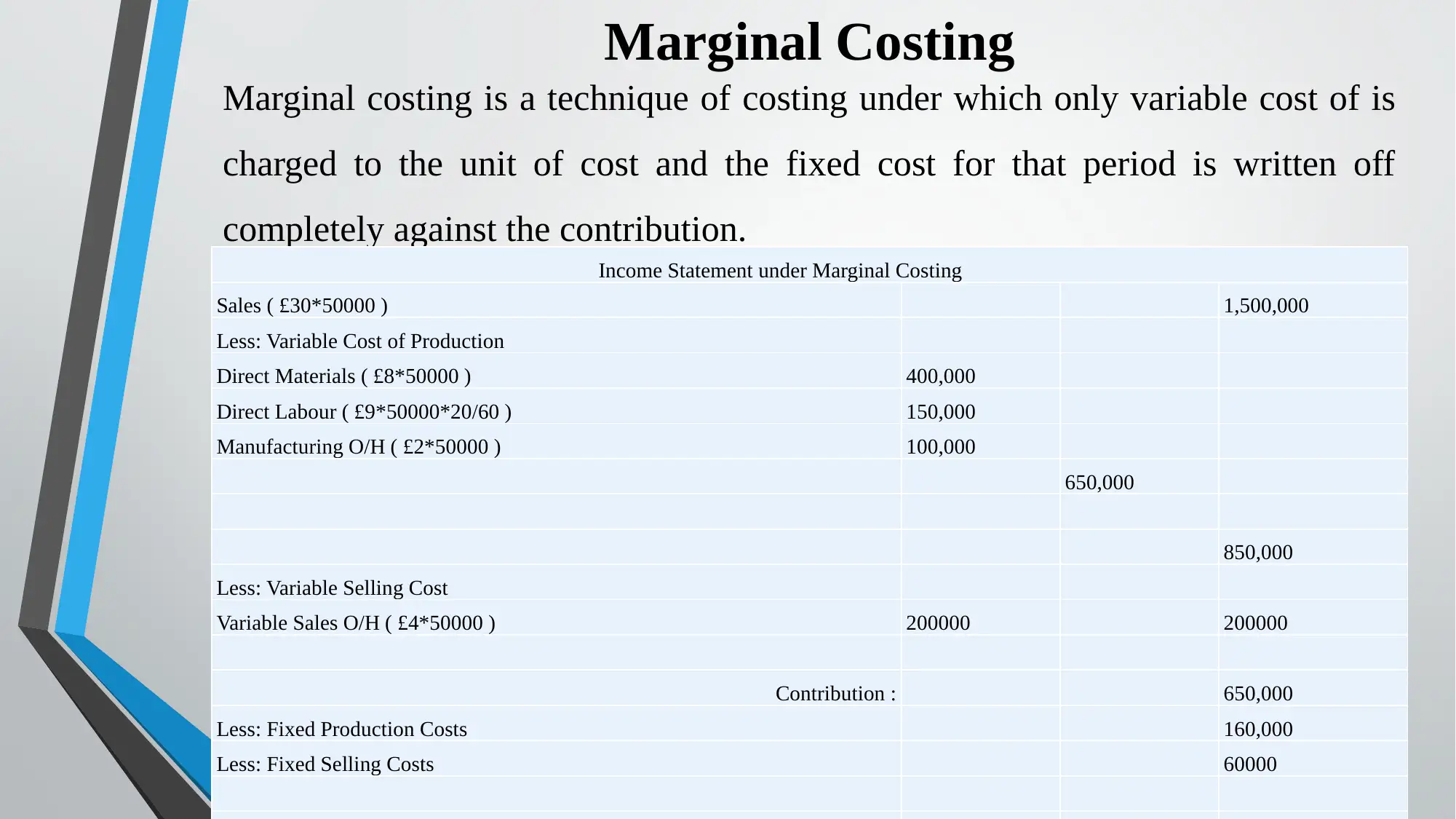
Marginal Costing
Marginal costing is a technique of costing under which only variable cost of is
charged to the unit of cost and the fixed cost for that period is written off
completely against the contribution.
Income Statement under Marginal Costing
Sales ( £30*50000 ) 1,500,000
Less: Variable Cost of Production
Direct Materials ( £8*50000 ) 400,000
Direct Labour ( £9*50000*20/60 ) 150,000
Manufacturing O/H ( £2*50000 ) 100,000
650,000
850,000
Less: Variable Selling Cost
Variable Sales O/H ( £4*50000 ) 200000 200000
Contribution : 650,000
Less: Fixed Production Costs 160,000
Less: Fixed Selling Costs 60000
Marginal costing is a technique of costing under which only variable cost of is
charged to the unit of cost and the fixed cost for that period is written off
completely against the contribution.
Income Statement under Marginal Costing
Sales ( £30*50000 ) 1,500,000
Less: Variable Cost of Production
Direct Materials ( £8*50000 ) 400,000
Direct Labour ( £9*50000*20/60 ) 150,000
Manufacturing O/H ( £2*50000 ) 100,000
650,000
850,000
Less: Variable Selling Cost
Variable Sales O/H ( £4*50000 ) 200000 200000
Contribution : 650,000
Less: Fixed Production Costs 160,000
Less: Fixed Selling Costs 60000
Paraphrase This Document
Need a fresh take? Get an instant paraphrase of this document with our AI Paraphraser
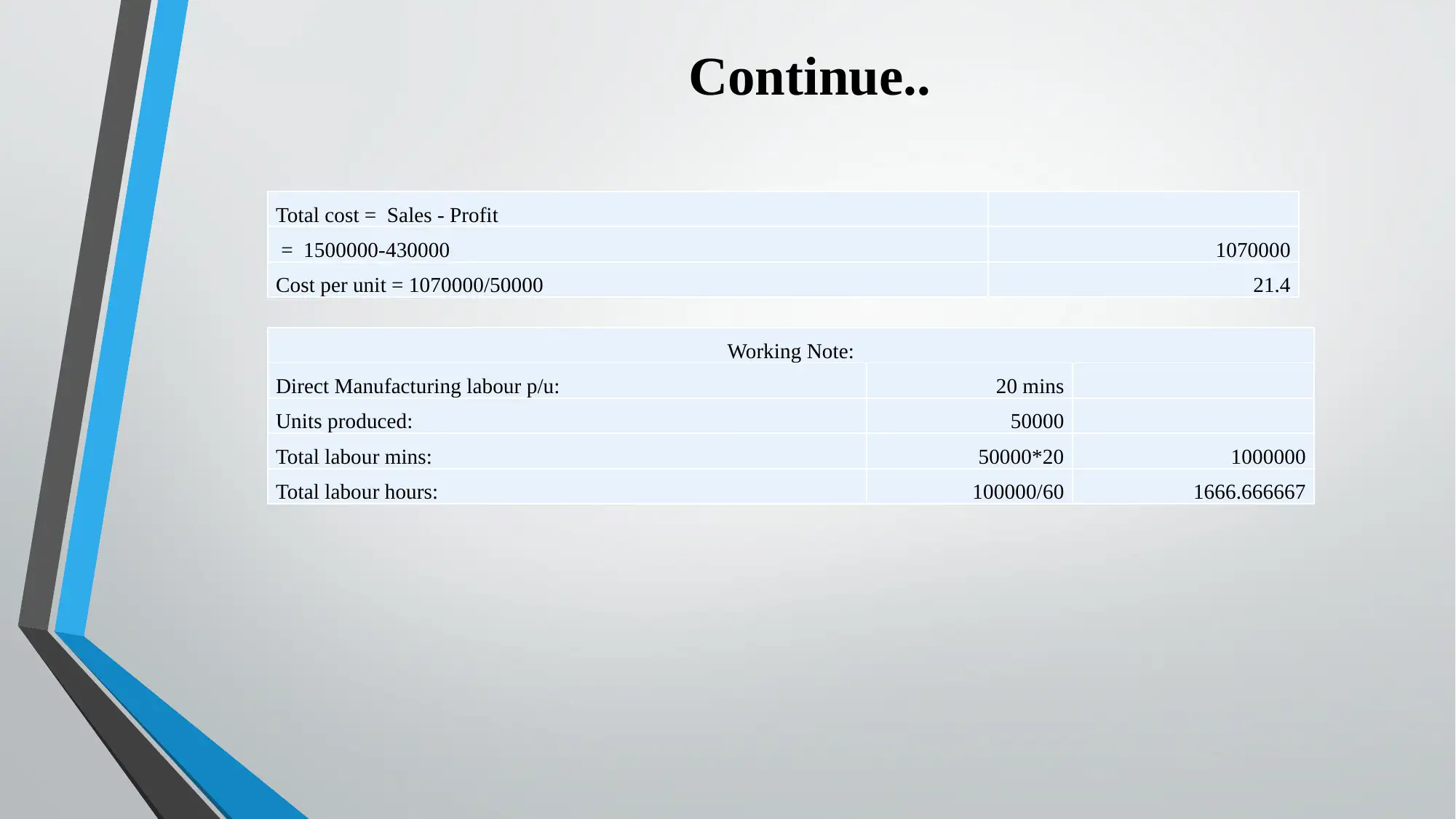
Continue..
Total cost = Sales - Profit
= 1500000-430000 1070000
Cost per unit = 1070000/50000 21.4
Working Note:
Direct Manufacturing labour p/u: 20 mins
Units produced: 50000
Total labour mins: 50000*20 1000000
Total labour hours: 100000/60 1666.666667
Total cost = Sales - Profit
= 1500000-430000 1070000
Cost per unit = 1070000/50000 21.4
Working Note:
Direct Manufacturing labour p/u: 20 mins
Units produced: 50000
Total labour mins: 50000*20 1000000
Total labour hours: 100000/60 1666.666667
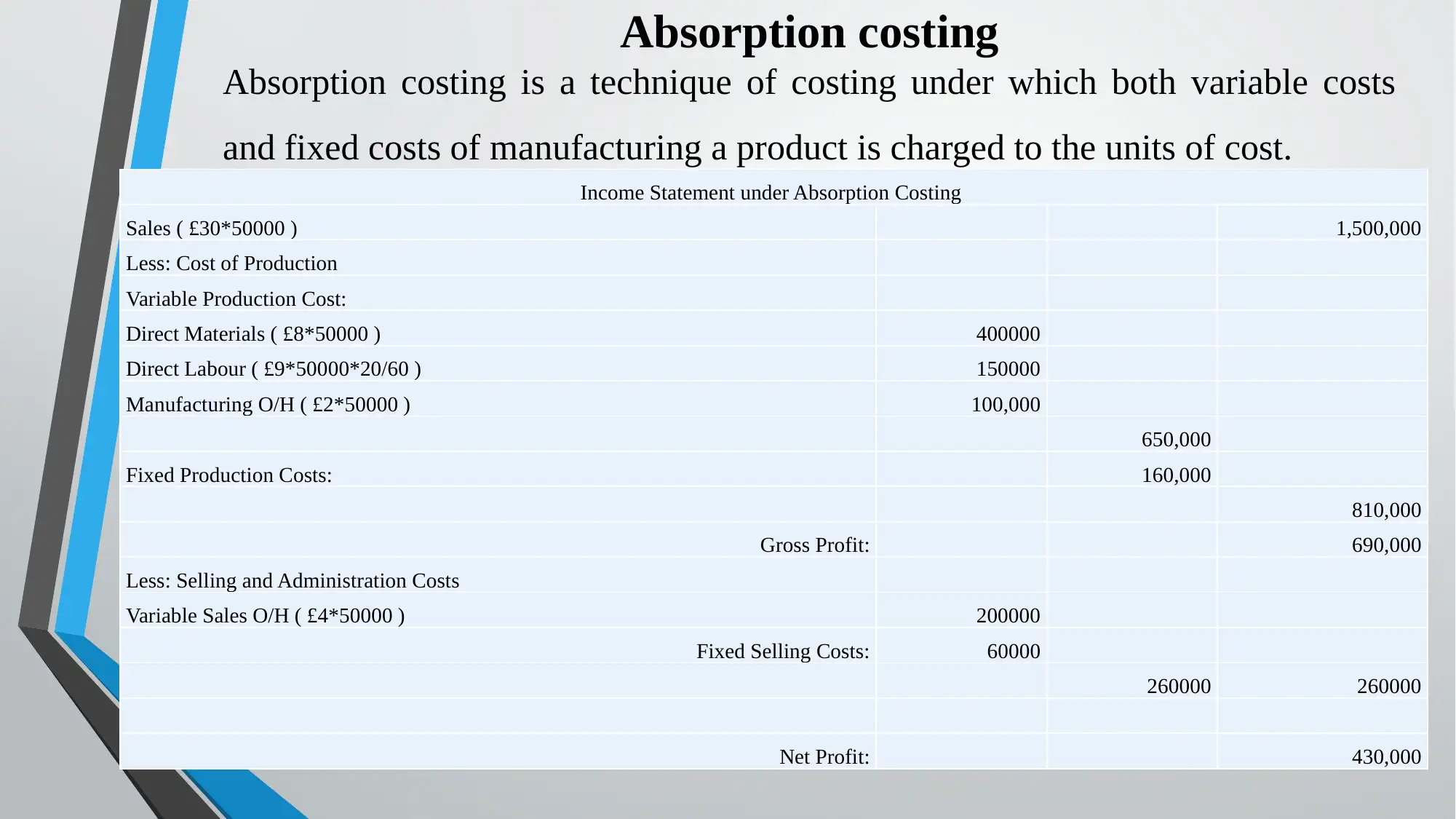
Absorption costing
Absorption costing is a technique of costing under which both variable costs
and fixed costs of manufacturing a product is charged to the units of cost.
Income Statement under Absorption Costing
Sales ( £30*50000 ) 1,500,000
Less: Cost of Production
Variable Production Cost:
Direct Materials ( £8*50000 ) 400000
Direct Labour ( £9*50000*20/60 ) 150000
Manufacturing O/H ( £2*50000 ) 100,000
650,000
Fixed Production Costs: 160,000
810,000
Gross Profit: 690,000
Less: Selling and Administration Costs
Variable Sales O/H ( £4*50000 ) 200000
Fixed Selling Costs: 60000
260000 260000
Net Profit: 430,000
Absorption costing is a technique of costing under which both variable costs
and fixed costs of manufacturing a product is charged to the units of cost.
Income Statement under Absorption Costing
Sales ( £30*50000 ) 1,500,000
Less: Cost of Production
Variable Production Cost:
Direct Materials ( £8*50000 ) 400000
Direct Labour ( £9*50000*20/60 ) 150000
Manufacturing O/H ( £2*50000 ) 100,000
650,000
Fixed Production Costs: 160,000
810,000
Gross Profit: 690,000
Less: Selling and Administration Costs
Variable Sales O/H ( £4*50000 ) 200000
Fixed Selling Costs: 60000
260000 260000
Net Profit: 430,000
⊘ This is a preview!⊘
Do you want full access?
Subscribe today to unlock all pages.

Trusted by 1+ million students worldwide
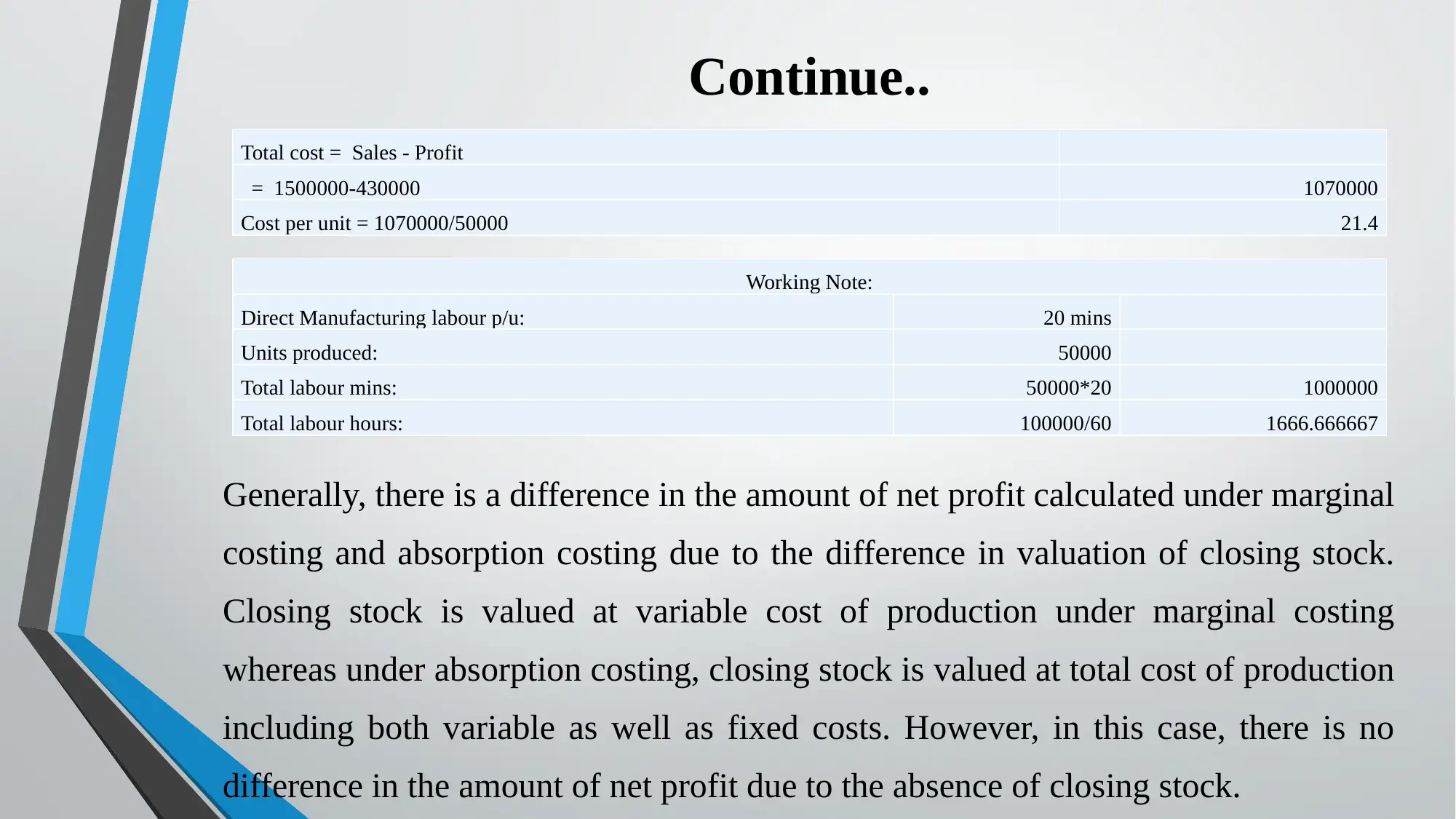
Continue..
Generally, there is a difference in the amount of net profit calculated under marginal
costing and absorption costing due to the difference in valuation of closing stock.
Closing stock is valued at variable cost of production under marginal costing
whereas under absorption costing, closing stock is valued at total cost of production
including both variable as well as fixed costs. However, in this case, there is no
difference in the amount of net profit due to the absence of closing stock.
Total cost = Sales - Profit
= 1500000-430000 1070000
Cost per unit = 1070000/50000 21.4
Working Note:
Direct Manufacturing labour p/u: 20 mins
Units produced: 50000
Total labour mins: 50000*20 1000000
Total labour hours: 100000/60 1666.666667
Generally, there is a difference in the amount of net profit calculated under marginal
costing and absorption costing due to the difference in valuation of closing stock.
Closing stock is valued at variable cost of production under marginal costing
whereas under absorption costing, closing stock is valued at total cost of production
including both variable as well as fixed costs. However, in this case, there is no
difference in the amount of net profit due to the absence of closing stock.
Total cost = Sales - Profit
= 1500000-430000 1070000
Cost per unit = 1070000/50000 21.4
Working Note:
Direct Manufacturing labour p/u: 20 mins
Units produced: 50000
Total labour mins: 50000*20 1000000
Total labour hours: 100000/60 1666.666667
Paraphrase This Document
Need a fresh take? Get an instant paraphrase of this document with our AI Paraphraser
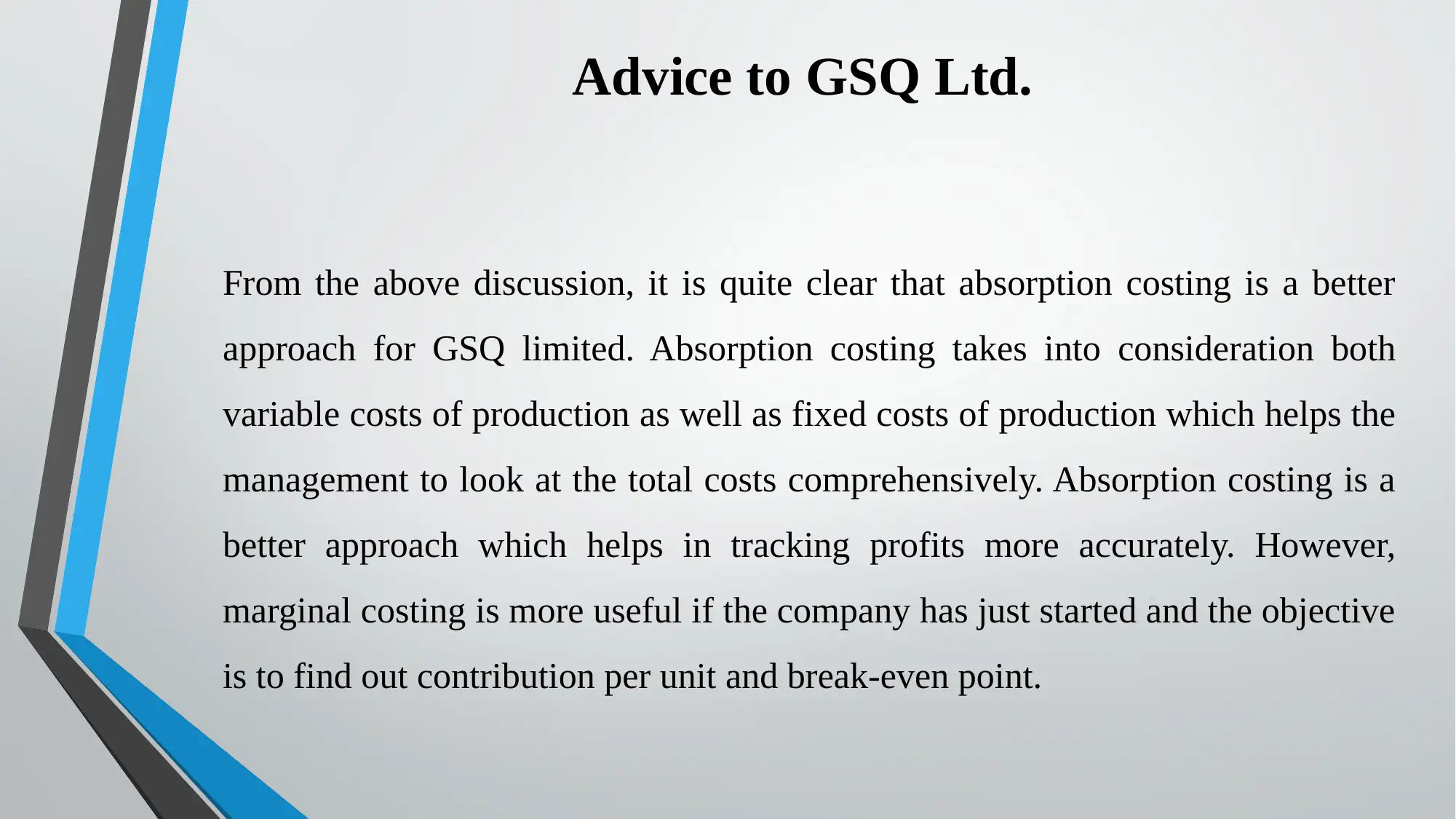
Advice to GSQ Ltd.
From the above discussion, it is quite clear that absorption costing is a better
approach for GSQ limited. Absorption costing takes into consideration both
variable costs of production as well as fixed costs of production which helps the
management to look at the total costs comprehensively. Absorption costing is a
better approach which helps in tracking profits more accurately. However,
marginal costing is more useful if the company has just started and the objective
is to find out contribution per unit and break-even point.
From the above discussion, it is quite clear that absorption costing is a better
approach for GSQ limited. Absorption costing takes into consideration both
variable costs of production as well as fixed costs of production which helps the
management to look at the total costs comprehensively. Absorption costing is a
better approach which helps in tracking profits more accurately. However,
marginal costing is more useful if the company has just started and the objective
is to find out contribution per unit and break-even point.
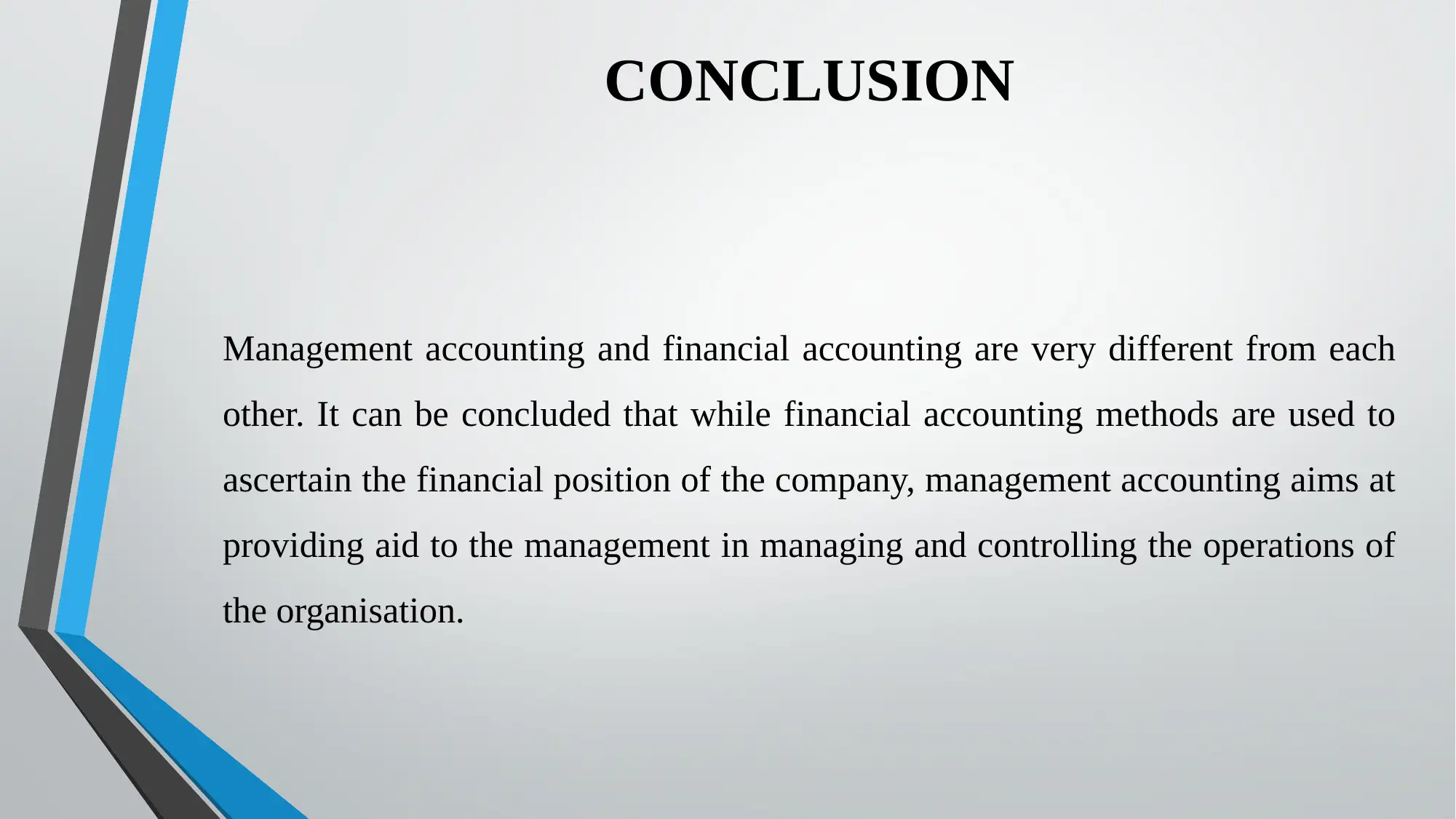
CONCLUSION
Management accounting and financial accounting are very different from each
other. It can be concluded that while financial accounting methods are used to
ascertain the financial position of the company, management accounting aims at
providing aid to the management in managing and controlling the operations of
the organisation.
Management accounting and financial accounting are very different from each
other. It can be concluded that while financial accounting methods are used to
ascertain the financial position of the company, management accounting aims at
providing aid to the management in managing and controlling the operations of
the organisation.
⊘ This is a preview!⊘
Do you want full access?
Subscribe today to unlock all pages.

Trusted by 1+ million students worldwide
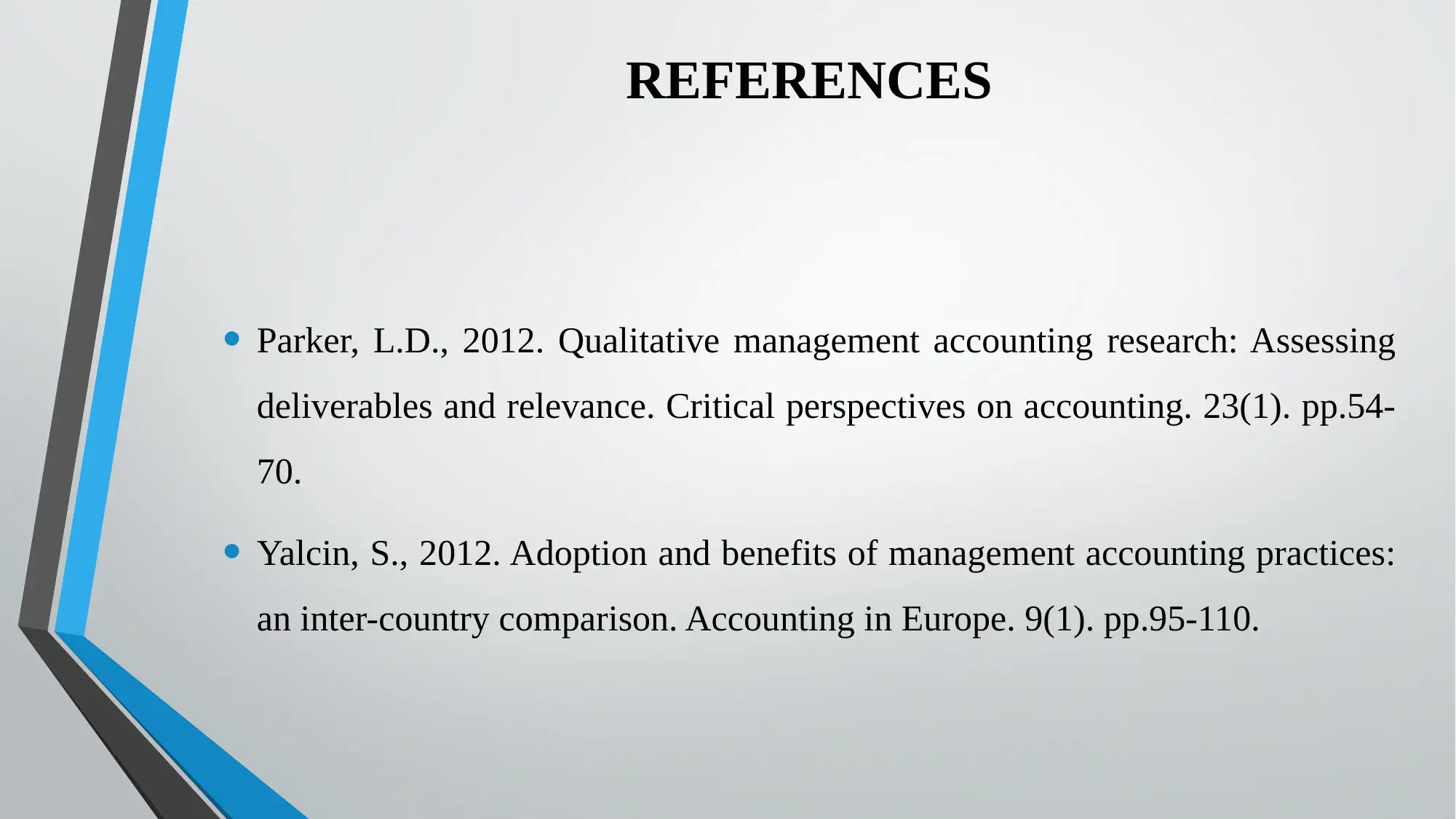
REFERENCES
• Parker, L.D., 2012. Qualitative management accounting research: Assessing
deliverables and relevance. Critical perspectives on accounting. 23(1). pp.54-
70.
• Yalcin, S., 2012. Adoption and benefits of management accounting practices:
an inter-country comparison. Accounting in Europe. 9(1). pp.95-110.
• Parker, L.D., 2012. Qualitative management accounting research: Assessing
deliverables and relevance. Critical perspectives on accounting. 23(1). pp.54-
70.
• Yalcin, S., 2012. Adoption and benefits of management accounting practices:
an inter-country comparison. Accounting in Europe. 9(1). pp.95-110.
Paraphrase This Document
Need a fresh take? Get an instant paraphrase of this document with our AI Paraphraser

THANKYOU
1 out of 11
Related Documents
Your All-in-One AI-Powered Toolkit for Academic Success.
+13062052269
info@desklib.com
Available 24*7 on WhatsApp / Email
![[object Object]](/_next/static/media/star-bottom.7253800d.svg)
Unlock your academic potential
Copyright © 2020–2026 A2Z Services. All Rights Reserved. Developed and managed by ZUCOL.




